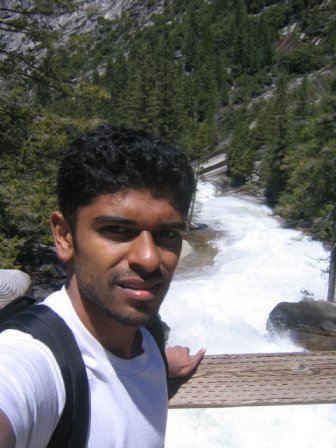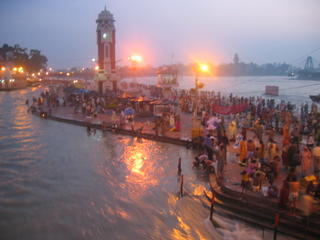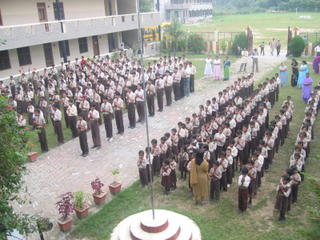LEH, LADAKH, JAMMU KASHMIR - Our first day in Ladakh, we went to the “Women’s Alliance Center” in Leh (the main city in Ladakh). We found out that they’re tied to ISEC (an England-based NGO -- www.isec.org.uk), and after hearing about their organization a little bit, we found out that they came to many of the same conclusions that SIDH came across. These two orgs have studied modern life and have really studied these rural areas, and Neil is right (see Sampat’s blogs), a lot of these rural areas are stuggling right now. But, why? It seems like every major problem that they have is a direct result of the steady infiltration of "development". The region in Uttaranchal that we visited has somehow been able to withstand "development" from creeping in... and one can see how life may have been in villages all over India at one point.
One of the basic beliefs of SIDH and ISEC is that the direction the world is going, and the “West” is pretty much there already... is a direction that is UNNATURAL. With the "global marketplace" and “free trade”, the West is now dragging regions like India in with them. However, this life-style is NOT sustainable... it uses up natural resources that are LIMITED. It creates garbage, when space for landfills is LIMITED (see blog entry about garbage). It uses more than it "needs" - i.e. eat until you can eat no more instead of eat as much as you need, water usage, etc. It is a very "artificial" lifestyle. What is the purpose of our (I'm talking about the general population) day-to-day lives in the U.S.? What are we working towards the MAJORITY of our time?
The place where we are now.. Ladakh (http://www.isec.org.uk/ladakh.html)... is an isolated region because it lies in a valley amongst the Himlayas in Jammu Kashmir. Their lives were in balance with nature and with the community around them, until the road from mainland India to LAdakh was built. Slowly, huge corporations were able to come in and push their "fertilizers, pesticides, and 'miracle seeds'". Many of these chemicals are outlawed in the U.S. because they are so poisonous, but these huge corporations don't mind selling them here. The farmers and villagers are never shown the true reality of the product. These corporations, and even the gov't, push farmers to grow one product well, so they can export them, instead of being a self-sustaining community (growing various products for a well-balanced diet as they’ve been doing for centuries).. Their lives are then controlled by the market forces... if the price of barley is 6 rupees per kg one year, versus 3 rupees per kg the next year... they may go hungry. They also, then, depend on others for various products, etc...
The ideal community seems to be the villages that still remain interdependent on each other in the community, but not dependent on external market forces. Wouldn't one say that these communities are the most "devleoped"? Their work and leisure is one. Their focus isn't on making more money, but it's on making enough to sustain themselves, and then being able to focus on family relationships, community relationships, spiritualness, etc. These are the other needs of human beings that are often ignored by the "West".
We watched this impressive video called "Ancient Futures - Learning from Ladakh" (you can order it from the website I wrote previously.. it's also a book… I really think that you should think about purchasing this video, and having a group showing or sumthing of that sort… it offers a different perspective of the world… and it also gives you a good idea of where we are right now!), that talks about the different problems Ladakh now faces, and how one can attribute each of these problems to the rapid arrival of "development". In the U.S. and the Western world, a lot of these problems are masked either purposely, or because "development" occurred over a 200 year time period and not all-of-a-sudden like it's happenning in many of these areas in India . Gradually, in the West, these problems arose in society, so it is difficult for people to realize the exact cause of the problems... but in Ladakh, "modernity" is coming fast, and one can easily see the problems that arise because of it.
When I talk about the problems "in the West" that can be attributed to unabated "development".. I'm talking about all sorts of problems. 1) Phyiscal problems - crime, pollution, deterioration of our environment in SOO many forms, lack of natural resources for the sustainability of the "modern" life, global warming, health issues because of the lack of physical work, fighting nature instead of living with nature, etc. 2) Emotional problems - the feeling of 'isolation' (i.e. old people not cared for, children at day care centers with strangers, human beings many times don't have any meaningful interactions with other human beings that aren't 'profit' related, etc.), lack of quality human relationships, the rise of 'depression', (lack of natural resources for the), 3) Mental problems - a one-dimensional view of the world that is a result of propaganda in education and media. 4) Spiritual problems – the goal of the West is “profit”, the goal of the ghams of India is something greater than “themselves” – some call it “spiritual development”, some call it “living for their families”, some call it “attaining God”, some call it “Nirvana”, etc.. but it’s something greater than themselves… they realize that the World does not revolve around them.
There are benefits of the West as well, a couple... 1) we have "security", financially, stability-wise, etc. (although, I'm beginning to realize that this comes at the expense of those around the world) and 2) we grow up with a global view (although sometimes biased).. There are those that don't realize that we have this "security" and will use their whole lives to "get more" and become "more secure". But, if we can realize this security that we have, we can really open our minds up and explore the world and try to find out the true reality of the world. We have the opportunity to truly follow "alternate" paths into spirituality, etc., and have the ability to make an impact on the world.
I understand Neil’s view of the "villager" that has never seen modern life (see the comment in Sampat’s blog)... never seen "city" life... and what's wrong in that desire to "explore" and do something new? That's fine... however, where is that desire coming from? Is it coming with a balanced and unbiased view of the world? Does he know about global warming, landfills, exploitation, crime rates, etc.? Or is it coming from a very biased view of the world? It seems to be coming from mass media that "glorifies" the "modern" lifestyle. It's coming from an education system that values people who sit behind a computer more than it values the person tending the fields. Even in the U.S., physical labor is looked down upon, while being "white collar" is "better". Why is it so? And then… brings me to another question… what is knowledge? We tend to believe that knowledge is what we learn in schools. Is knowledge how to operate a computer system, how to program, etc.... or is knowledge knowing how to farm your land, realizing when the ideal time is to plant seeds or harvest, knowing how to spin your own cloth, knowing how to milk a cow, etc.? They both are knowledge, but since you can get a B.S, in one, while the other you learn through real experience… the modern world places a greater value on the one you can get a degree in. If 4 of us were dropped in the middle of no where and there was fertile land around us..... versus 4 farmers from an Indian village were dropped in the middle of no where... who would have the better chance to survive? Probably the villagers... then... what's true knowledge? What good is our knowledge there... in the most natural of environments. (I'm just thinking of this example now... and I'm sure there are holes in my logic.. but you get what I'm saying...).
The education system deems the "modern" world as "developed" and the "traditional" world as “backwards”. How does it do so? Especially in India, the purpose of education, especially once you get past the 7 and 8th classes, is to get to college, and get a job in a city. Why? In their textbooks, it never talks about the positives of physical labor, farming, etc.. but it talks about the positives of "industrialization". They don't learn to value their local customs, beliefs, traditions… but they learn trigonometry (what use is that to them in the village?) The curriculum used is usually a national one… but India is not a MONOLITHIC culture… it’s a culture that is so DIVERSE and this DIVERSITY still remains… but the education system and mass media and even the gov’t. seem to be trying to create a MONOLITHIC Indian culture, although over thousands and thousands of years this has never been the case and India has floursished. The U.S.A. is pretty much a monolithic culture… one may say that it is dilithic (I think I made that word up) as there is “rural” American versus “urban” America. Therefore, a universal education system, a universal system of economy, etc. can work. However, what works in one part of the world is not the answer in all parts of the world. The culture of South Asia is tied together by spirituality, but still retains its diversity in way of life. Does it make any sense that this region of Ladakh where Ladakhi is their primary language… they got taught in Urdu and English at school? Urdu is the state language of Jammu Kashmir, and English is the “language of the future”. Political lines and boundaries are also part of this “unnatural” way of life… and result in the slow decline of cultural diversity.
I agree that India is definitely NOT shining…. I would assume, as well, that many villages aren’t at operational levels… especially in UP, Bihar, Karnataka, Tamil Nadu, etc. But why? What’s the cause of the poverty and famine in villages? There have been soooo many dams built in India, so this water can be sent to the cities…. In the process, this has flooded out many villages. It has also cut off the water supply (the lifeline) to many other villages. These villagers had been living naturally balanced lives for GENERATIONS, but now, are told to pack up and relocate. The gov’t covers this up by giving them large sums of money and sometimes land…. but what does this really do? They can’t really resettle there. Different crops grow well, they have to relearn everything, find a new supply of water, rebuild homes, etc. etc. That village is devastated and many migrate to the slums of cities. In other places, the gov’t has deemed it important to “educate” them… so, they’ve opened schools, etc. However, when the young men of these communities migrate to the cities… it leaves families behind in disarray. There are no longer enough people to tend the farms, and when people start earning money, the joint families tend to break up and nuclear families are formed. In the study done by SIDH, it shows that a nuclear family will have more problems surviving in an agrarian economy. Nuclear families also have to have more children to tend the farm, while in joint families, they generally have less children . Not having electricity… is that necessary a bad thing? If one is used to it, then one sees it as a necessity.. but, if one is not used to it… then it is only a luxury (such as driving around in a Beamer instead of a ’90 Geo Prizm).
But you do bring up a very good question… India is on the path towards modernity… the cities are well down that road… some villages have already been affected…. And some other villages have still been able to sustain its natural way of life. So, what now?
The easy answer… is to continue this path of “development”. However… as I’ve talked about earlier, this “path” isn’t sustainable, and is devastating in so many ways. Especially for India, with a population of 1 billion, there is no way, the population can live like America lives… the world’s resources would be used up in the matter of years. Most likely, the result will just be a growth of the slums surrounding the already overcrowded cities of India.
The difficult answer… is to reverse the trend. To educate those that still live the traditional life about the positives and NEGATIVES of “modernity”, and to educate them about their own local customs, traditions, way-of-life, etc. How about those (like us) that are already living the “aritificial” life? This question seems to be much more difficult, because it requires a huge amount of sacrifice on a massive scale.
“Jivan Vidhya” is the philosophical base behind “SIDH”… and they now hold 7-day shibhirs all around India in Hindi and English. The shibhirs are full of lectures, discussions, interactions, etc. The participants range from villages, to IIT professors, to spiritual leaders, to students (and soon to a couple of Americans called Raj and Sameer). They have a very basic website at
We’re still out here learning, and would love to hear about people’s views about this… and various experiences, etc… Hopefully, as we learn more and experience more, we’ll also come across some plausible solutions….











